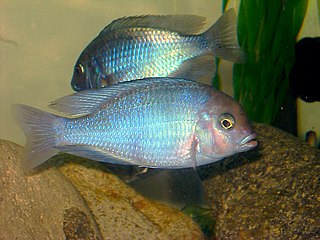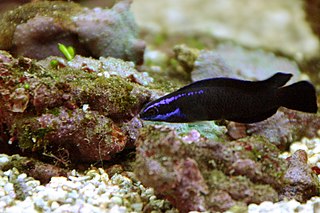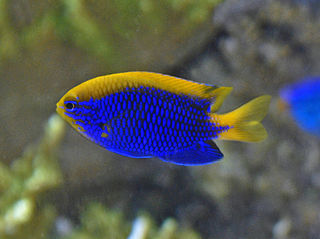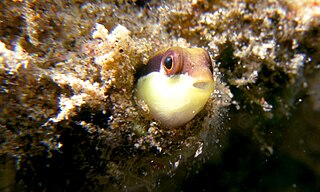
The black neon tetra is a freshwater fish of the characin family of order Characiformes. It is native to the Paraguay basin of southern Brazil. They are often found in the aquarium trade.

The sarcastic fringehead is a small but very hardy saltwater fish that has a large mouth and aggressive territorial behavior, for which it has been given its common name. When two fringeheads have a territorial battle, they wrestle by pressing their distended mouths against each other, as if they were kissing. This allows them to determine which is the larger fish, which establishes dominance.

Maylandia estherae is a haplochromine cichlid. It is a rock dwelling fish or mbuna from Lake Malawi. This fish, like most cichlids from Lake Malawi, is a mouthbrooder - females hold their fertilized eggs then fry in their mouths until they are released after about 21 days.

Heterotilapia buttikoferi, also known as the zebra tilapia, is a West African species of cichlid.

The threadfin rainbowfish or featherfin rainbowfish is a rainbowfish, the only species in the genus Iriatherina. It is characterized by long beautiful fins, and is among the most attractive of the rainbowfishes.

The Japanese angelfish or Japanese pygmy angelfish is a species of marine ray-finned fish, a marine angelfish belonging to the family Pomacanthidae. It is found in the western Pacific Ocean.

Cyrtocara moorii, commonly known as the hump-head, is a species of haplochromine cichlid endemic to Lake Malawi in east Africa where they prefer areas with sandy substrates. It can grow to a length of 20 centimetres (7.9 in) TL. The species is popular among aquarium keepers where it is known as the hump-head cichlid, blue dolphin cichlid, Malawi dolphin or simply as moorii. It is currently the only known member of its genus. The specific name honours the English cytologist and biologist John Edmund Sharrock Moore (1870-1947).

Reganochromis calliurus is a species of cichlid endemic to Lake Tanganyika in East Africa. It lives over a sandy substrate in deeper coastal waters, to depths of at least 60 m (200 ft). Its preferred diet consists mostly of shrimp. It can reach a total length of 15 cm (5.9 in). This fish can also be found in the aquarium trade. It is currently the only known member of its genus.

Chalinochromis brichardi is a species of fish in the family Cichlidae. It is found in Burundi, the Democratic Republic of the Congo, Tanzania, and Zambia. It is endemic to Lake Tanganyika. It builds a nest of rubble which is hidden by plants or algae, and its diet consists primarily of invertebrates. The specific name of this fish honours the fish dealer Pierre Brichard (1921-1990), who was the collector of the type.

The electric blue hap is a species of cichlid fish endemic to Lake Malawi. It prefers to live in caves and crevices in rocky substrates. This species can reach a length of 20 centimetres (7.9 in) TL. It can also be found in the aquarium trade.

The royal dottyback, also called the bicolor dottyback or false gramma is a fish commonly kept in marine aquariums. The front of the fish is bright purple and the posterior is yellow. In an aquarium, it will grow up to three inches long. The dottyback will defend its territory against fish several times its size, but gets along with many other common aquarium fish. This is sometimes mistaken for a royal gramma.

Pseudochromis fridmani is a species of fish in the family Pseudochromidae, the dottybacks. Its common name is orchid dottyback. It is endemic to the Red Sea.

Pseudochromis springeri, also known as blue-striped dottyback, is a popular saltwater aquarium fish from the red sea and eastern Indian Ocean. The specific name honours the American ichthyologist Victor G. Springer of the Smithsonian Institution.

Chrysiptera hemicyanea, known commonly as the azure damselfish, azure demoiselle, half-blue demoiselle, and yellow-dipped damsel, is a species of damselfish.

Chrysiptera starcki is a species of damselfish known by the common name Starck's demoiselle. It is native to the western Pacific Ocean, where it has been reported from the Ryukyu Islands and Taiwan to Australia, New Caledonia, and Tonga. It was originally described in 1973 as Abudefduf starcki.

Amblyeleotris wheeleri, the Gorgeous prawn-goby, is a species of goby native to tropical reefs of the Indian Ocean to the western Pacific Ocean. It can be found at depths of from 5 to 40 metres though is usually does not occur deeper than 15 metres (49 ft). It is a commensal with alpheid shrimps, most often being found in association with Alpheus ochrostriatus. This species can reach a length of 10 centimetres (3.9 in) SL. It can also be found in the aquarium trade. The specific name honours the English ichthyologist Alwynne Cooper Wheeler (1929-2005), who was curator of Fishes at the British Museum, "for his help over the years, particularly with the authors’ study of prawn-associated gobies of the Seychelles".

Pseudochromis sankeyi, the striped dottyback, is a species of ray-finned fish from the Western Indian Ocean which is a member of the family Pseudochromidae. It occasionally makes its way into the aquarium trade. It grows to a size of 7 cm in length. The specific name honours the British collector and wholesaler of marine fish Richard D. Sankey, who gave Roger Lubbock study specimens.
Manonichthys alleni, the Sabah dottyback is a species of ray-finned fish from the family Pseudochromidae, the dottybacks. It occasionally makes its way into the aquarium trade. It grows to a size of 12 centimetres (4.7 in) in length. This dottyback has only been known from Indonesia and Malaysia, but was recently recorded in the Davao Gulf in the southern Philippines. The specific name honours the ichthyologist Gerald R. Allen of the Western Australian Museum in Perth who collected the type specimen and provided photographs of this species which Gill used in his description, as well as being in recognition of Allen's contribution to the knowledge of Indo-Pacific fish and of the support Allen gave Gill in is work on the Pseudochromidae.

Apistogramma agassizii is the scientific name for the Agassiz's dwarf cichlid, a fish that occurs in many Southern tributaries of the Amazon river. Its specific name honours the Swiss-American zoologist and geologist Louis Agassiz (1807-1873).

Apistogramma hongsloi is a species of dwarf cichlid fish, native to the Orinoco basin in South America. They are often kept in the aquariums and prefer to have soft, acidic water.


















